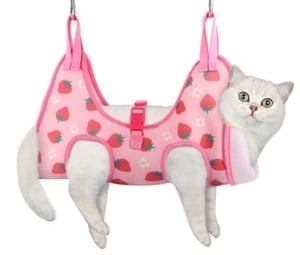
Getting a grooming restraint is a wise investment if just for the fact that it will expedite matters. Not having to fight with your cat can make it easier to get things done. Our guide covers the things you should know before buying a product. We’ve also included detailed reviews to help you choose which one is most suitable for your feline.
A Quick Comparison of Our Favorites in 2024
| Image | Product | Details | ||
|---|---|---|---|---|
| Best Overall |
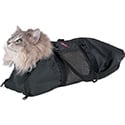
|
Top Performance Cat Grooming Bag |
|
CHECK PRICE |
| Best Value |
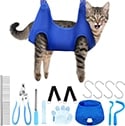
|
Ferraycle Pet Grooming Hammock |
|
CHECK PRICE |
| Premium Choice |
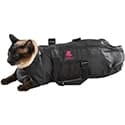
|
Top Performance Heavy Duty Mesh Cat Grooming Bag |
|
CHECK PRICE |
| Best for Kittens |
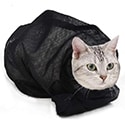
|
ASOCEA Cat Grooming Bag |
|
CHECK PRICE |
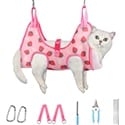
|
Supet Cat Grooming Hammock |
|
CHECK PRICE |
The 8 Best Cat Grooming Harnesses
1. Top Performance Cat Grooming Bag – Best Overall
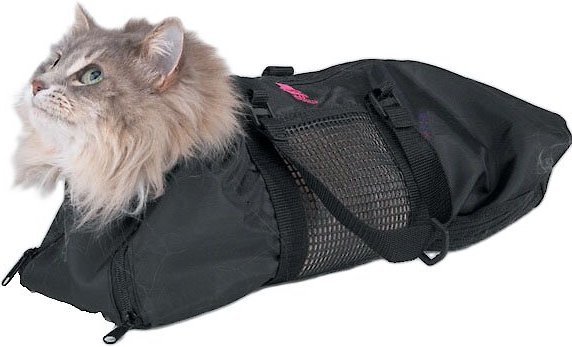
| Available sizes: | Small, medium, large |
| Materials: | Polyester |
| Ease of use: | Easy |
| Cleaning: | Spot clean only |
The Top Performance Cat Grooming Bag is an excellent choice for cats that are used to being restrained. It’ll keep your kitty under control as long as they don’t fight the process too much. It has four zippered openings to get to each paw individually for nail clipping. There is a handle on the top for quick transport, making it our pick for one of the best overall cat grooming harnesses.
The bag’s design makes it simple to put on your cat. Of course, getting your pet used to it is imperative to make the process more streamlined. It has mesh to keep your kitty comfortable and cool, but there is perhaps too much restraint for extra feisty felines.
- Allows optimal control
- Affordably priced
- Zipper access to all four paws
- Breathable mesh
- Not durable enough for determined cats
2. Ferraycle Pet Grooming Hammock – Best Value
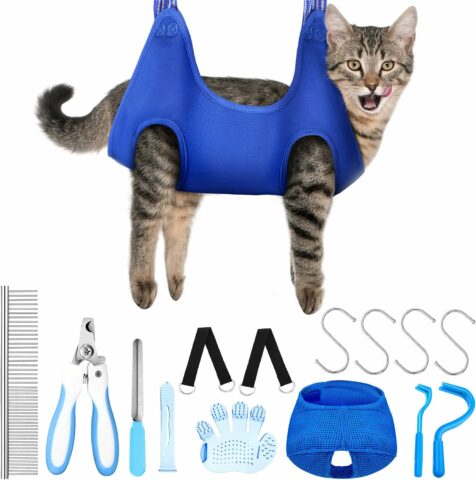
| Available sizes: | One size |
| Materials: | Polyester |
| Ease of use: | Fair |
| Cleaning: | Machine-washable |
The Ferraycle Pet Grooming Hammock gives you full access to your cat for any task, from medical treatments to nail clipping. The leg openings make it harder for your kitty to escape without chafing. The product includes some extra goodies to get you started, including a nail trimmer, brush, muzzle, comb, and more. It’s our pick for one of the best cat grooming harnesses for the money because of all these inclusions.
The extras are of good quality, which was a pleasant surprise. Often, these add-ons are flimsy. We like that it’s machine washable as well. However, it’s not the most straightforward product to use. Determined pets probably won’t tolerate it.
- Machine washable
- Extra tools included
- Sturdy
- Not suitable for reluctant pets
3. Top Performance Heavy Duty Mesh Cat Grooming Bag – Premium Choice
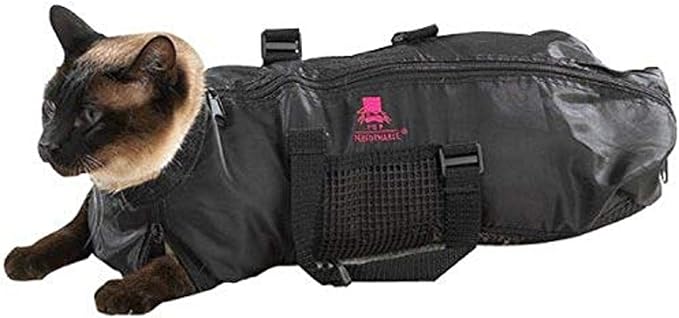
| Available sizes: | Small, medium, large |
| Materials: | Polyester, rubber, velcro |
| Ease of use: | Easy |
| Cleaning: | Spot clean |
“Heavy-duty” is the only way to describe the Top Performance Heavy Duty Mesh Cat Grooming Bag. This product helps get the job done by restraining your pet with an easy-to-use and sturdy product. It’s well-designed and sturdy to keep your kitty restrained, and it has handles for transporting and a hook for a grooming table.
The grooming bag works as described. However, some pet owners may think it’s too constrictive, even if it’s necessary for some cats. We thought the design provided an excellent way to protect both you and your pets, though. The material is extremely durable, so you can use it for more than just everyday maintenance tasks at home.
- Sturdy
- Handles and hanging hook
- Easy to use
- Some think it’s too constrictive
4. ASOCEA Cat Grooming Bag – Best for Kittens
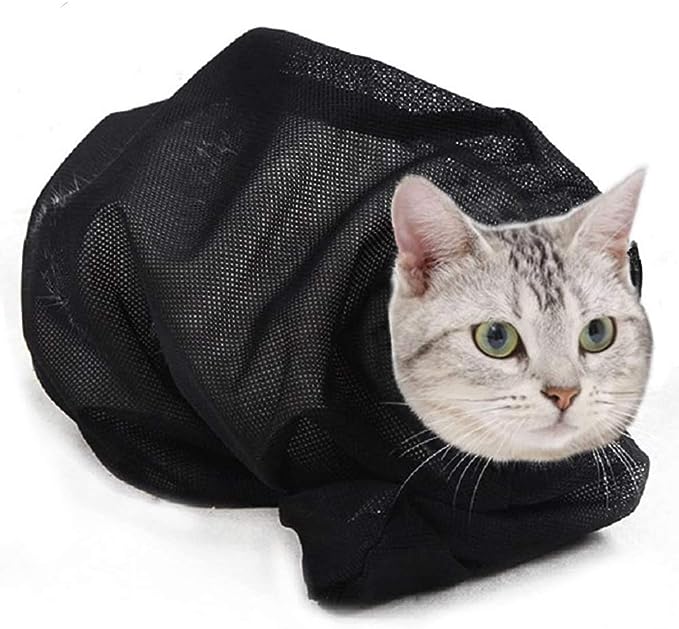
| Available sizes: | One size fits all |
| Materials: | Nylon mesh |
| Ease of use: | Fair |
| Cleaning: | Spot clean |
The ASOCEA Cat Grooming Bag is a decent product if your pet doesn’t fight restraint a lot. The design contains your kitty but isn’t the easiest to use with a reluctant cat. It’s a product that has a learning curve for you and your pet. The nylon material is a good choice since it won’t chafe, while still offering some durability. We’d recommend this product for kittens, but not adults that could put up a good fight, despite it being one size fits all.
It uses an adjustable drawstring to secure the cat. That’s a wise choice since you can get it as snug as you need to keep your cat from escaping. The mesh makes it breathable without losing too much durability, too. However, because of the limited holes, you’re going to have to wrestle with your cat a bit.
- Adjustable
- Lightweight
- Breathable
- Hard to maneuver your cat while inside
5. Supet Cat Grooming Hammock
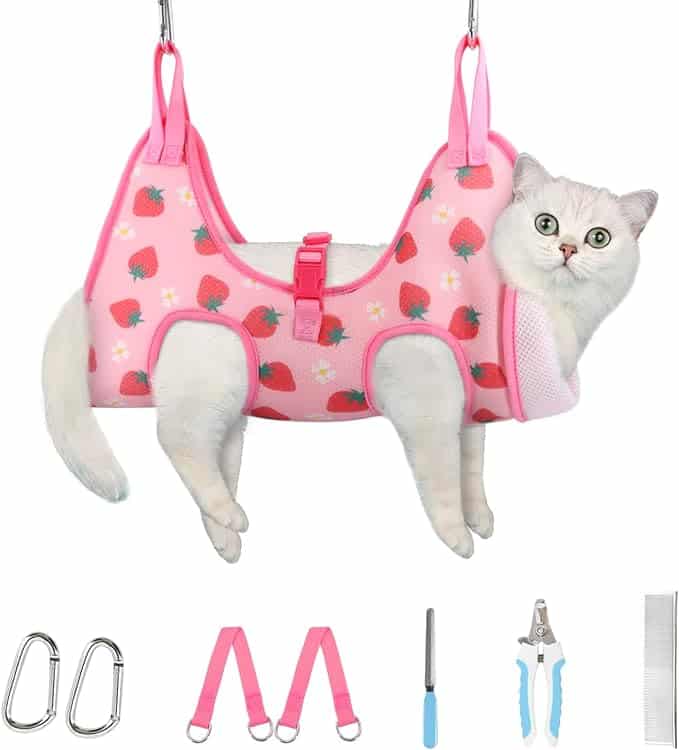
| Available sizes: | X-small to large |
| Materials: | Polyester |
| Ease of use: | Easy |
| Cleaning: | Spot clean |
The Supet Cat Grooming Hammock is a well-designed product that is versatile and attractive with its adorable color and pattern choices. It uses a carabiner attachment for added security on a grooming table. It includes some extra goodies for a complete package, and it’s easy to use and sturdy once you have your cat inside it. You can also use it for small dogs, making it a value-priced product.
The hammock design is a good choice for pets since it’ll keep them restrained in an unfamiliar position. It’s a good choice if you have to do other trimming and must keep your cat still to do it. However, there have been reports of sizing issues.
- Adorable color and pattern choices
- Includes nail clippers, files, and slings
- Sturdy material
- Some sizing issues
6. JDMYCYCQXF 2023 Cat Grooming Hammock
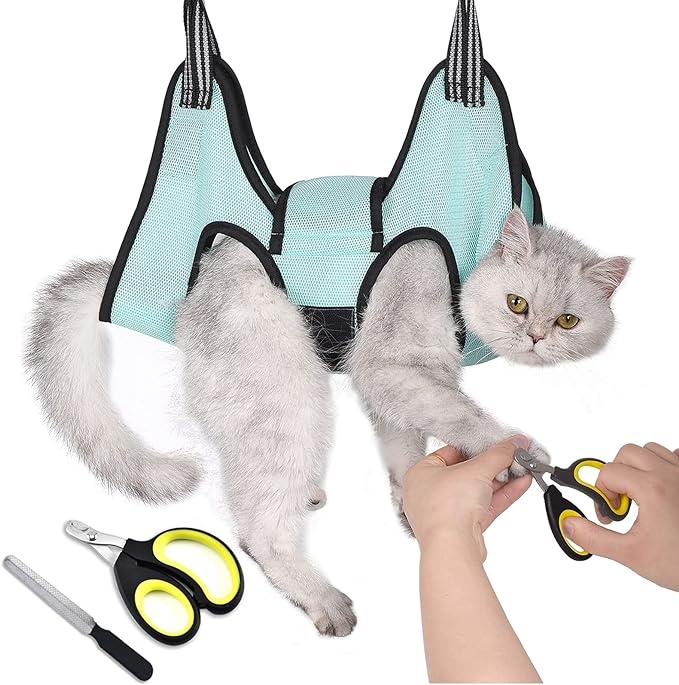
| Available sizes: | Three sizes |
| Materials: | Polyester |
| Ease of use: | Fair |
| Cleaning: | Spot clean |
The JDMYCYCQXF 2023 Cat Grooming Hammock is a good choice for use with a grooming table. It has a broad base that will secure your pet, although it may be uncomfortable for some animals. The leg openings are wide, which makes it easy to get your kitty’s legs through them. However, that’s a two-way street when it comes to escaping.
The price is right and includes some extra goodies. However, it also has some compromises, as we’ve mentioned, making it less than a slam dunk. It’s best used for cats accustomed to being restrained in this way.
- Adjustable and comfortable
- Extra goodies included
- Affordably priced
- Uncomfortable for some pets
- Larger leg holes
7. Cinf Cat Grooming Restraint Bag
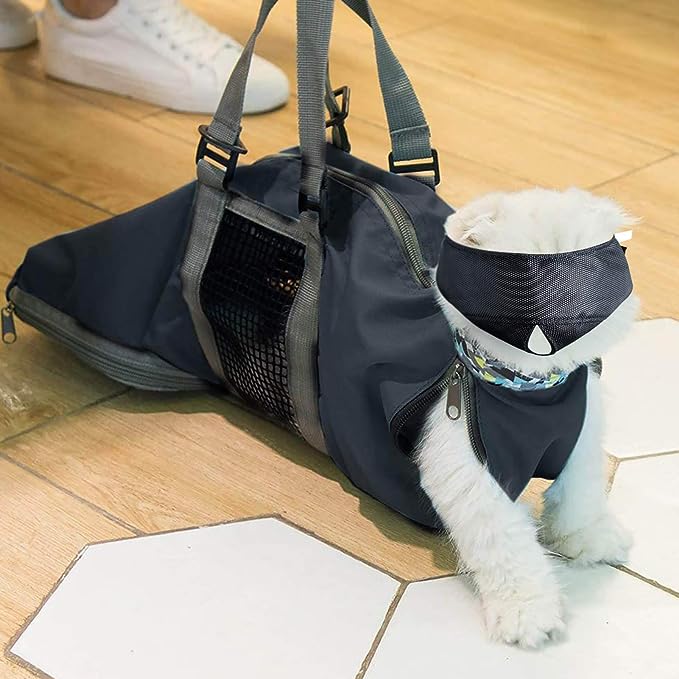
| Available sizes: | Two sizes |
| Materials: | Polyester |
| Ease of use: | Moderate |
| Cleaning: | Spot clean |
The Cinf Cat Grooming Restraint Bag is best used for quick tasks since it’s not the most comfortable for keeping pets inside it for longer periods. The polyester material is sturdy and can handle everyday use. It’s not the easiest restraint to put on your pet, but you can rest assured they will stay secure inside. However, the product includes a muzzle to keep everyone safe.
The design is thoughtful, with the mesh in the center and outside of your kitty’s reach, that retains its breathability yet keeps your pet secure.
- Included muzzle
- Well-placed mesh
- Long handle
- Not suitable for overweight cats
- Some cats will not like the muzzle
8. Freshly Bailey Cat Grooming Hammock
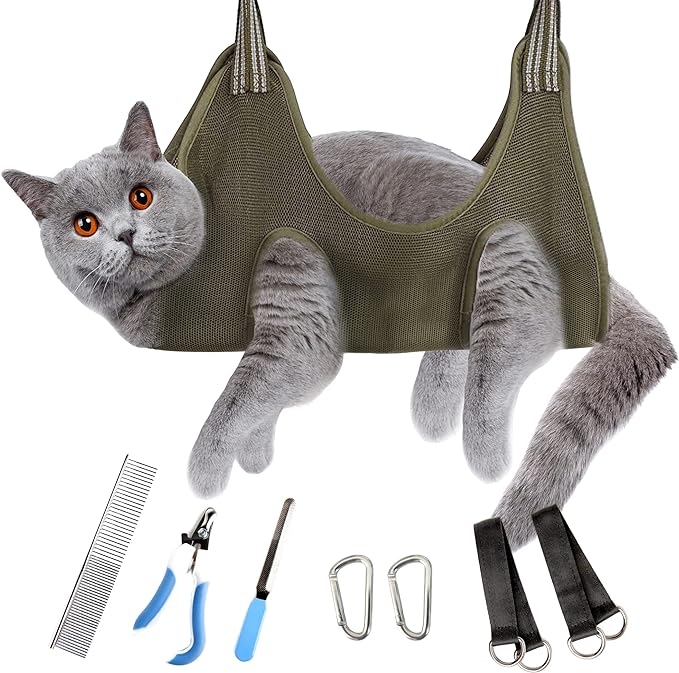
| Available sizes: | Four sizes |
| Materials: | Polyester, fur |
| Ease of use: | Fair |
| Cleaning: | Spot clean |
The Freshly Bailey Cat Grooming Hammock is a nice product that will keep your pet secure with carabiners to attach it to a table. The design will restrain your kitty effectively so that you can make use of the added tools, like the file. It will also distribute our cat’s weight to make it more comfortable. The leg openings are appropriately sized as well.
You can use this product with cats and small dogs. It works for both animals. The extra items are well-made to make it excellent value. However, some reviews point out that there are quality control issues and that their cats were able to escape quickly.
- Extra goodies
- Padded design
- Secure attachments
- Quality control issues
- Cats seem to escape quickly
Buyer’s Guide: Choosing the Best Cat Grooming Harnesses
The chances are that a cat restraint is a new purchase for you. Regular harnesses won’t cut it. When it comes to doing at-home grooming, the better option for felines is a bag. It keeps their claws from inflicting injury on you or your pet. You can work with one paw at a time so you can keep your focus on the task at hand. Many products are even made of mesh so that you can bathe your cat or treat a flea infestation.
You probably know that your cat isn’t going to like being groomed. They won’t like being restrained, either. While some products may seem cruel, they really have your pet’s best interest in mind. Some manufacturers toss in a muzzle, which serves the same purpose.
- Sizing
- Materials
- Ease of use
- Cleaning
Sizing
A snug fit is imperative to keep your pet restrained. Good luck trying to get your cat into another one if they escape from a flimsy product! You should measure the length and width of your pet. Many manufacturers post approximate weights with the various sizes, which can give you a decent idea of which one to get. The neck opening is crucial to keeping your kitty secure. Remember that it should be snug but not too tight.
Materials
Mesh is optimal for circulation, but it’s also vulnerable to a sharp set of claws. Look for materials that are durable and can handle the punishment an angry cat is likely to inflict on them. Consider the other parts for holding the bag and attaching it to some type of anchor. We also suggest looking at the placement of the zippers and how easy they’ll make using the product.
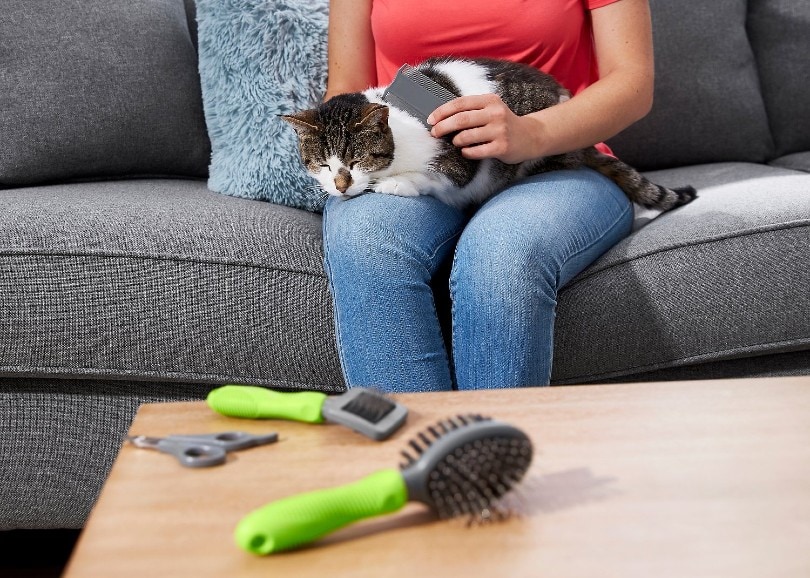
Ease of Use
Getting your cat inside of a grooming bag isn’t a lot different than using a carrier. You need a wide opening to put the animal inside and a quick way to close it to prevent escape. Most of the products we reviewed are soft-sided. That makes them lighter and more manageable to wield. We suggest looking at the closures to ensure they’re straightforward to use.
Cleaning
Many products we reviewed are spot clean only. That’s understandable, given the materials they use. Look for descriptions like “quick-drying” if you think it may be an issue. Most manufacturers will indicate whether you must hand wash an item or if you can toss it in the washer or dryer. We recommend heeding these instructions since it could affect a product’s durability.
The Hepper Advanced Bio-Enzyme Pet Stain & Odor Eliminator Spray is our favorite enzyme cleaner out there. It permanently removes even the very worst kitty stains and smells, leaving your home fresh and clean! Click here to learn more about this amazing product and get yourself a bottle. At Catster, we’ve admired Hepper for many years, and decided to take a controlling ownership interest so that we could benefit from the outstanding products of this cool cat company!
Conclusion
After conducting our reviews, a clear winner rose to the top. The Top Performance Cat Grooming Bag gets the job done with a practical design that gives pet owners easy and protected access, making it our pick for the best overall cat grooming harness. On the other hand, the Ferraycle Pet Grooming Hammock works well with a grooming table to restrain cats effectively as long as they are not fighters. The price is right, too, making it the best cat grooming harness for the money.
However, there are lots of options out there, so if you did not find one you love, be sure to check out the buyer’s guide to know exactly what you need to be looking for.
Featured Image Credit: Supet, Amazon
Contents
- A Quick Comparison of Our Favorites in 2024
- The 8 Best Cat Grooming Harnesses
- 1. Top Performance Cat Grooming Bag – Best Overall
- 2. Ferraycle Pet Grooming Hammock – Best Value
- 3. Top Performance Heavy Duty Mesh Cat Grooming Bag – Premium Choice
- 4. ASOCEA Cat Grooming Bag – Best for Kittens
- 5. Supet Cat Grooming Hammock
- 6. JDMYCYCQXF 2023 Cat Grooming Hammock
- 7. Cinf Cat Grooming Restraint Bag
- 8. Freshly Bailey Cat Grooming Hammock
- Buyer’s Guide: Choosing the Best Cat Grooming Harnesses
- Conclusion















